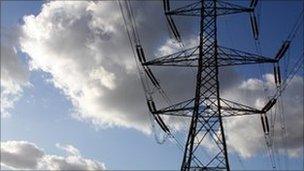Meeting rejects Beauly-Denny plan
- Published

Concerns have been raised over the visual impact of the power line
More than 200 people at a public meeting have voted against Scottish Power's plans to reduce the impact of the Beauly to Denny electricity line.
The Scottish government has approved the line but required Scottish Power to work with the council to mitigate the effect of pylons around Stirling.
The public meeting was called by Stirling Council, to help it formulate its response to the mitigation plan.
Scottish Power said it could meet the conditions by painting and planting.
The chair of Stirling Council's Power Line steering group, Councillor Calum Campbell, said that was not adequate.
He said: "When you have 50-metre-high towers, I'm afraid planting trees and painting the pylons is not effective visual mitigation."
The council's preferred option is for the high-voltage line to be buried underground.
Technical experts
Scottish Power has rejected calls to bury the controversial line in the countryside around the town.
Ministers approved the 440kv power line upgrade in January 2010. It will consist of a network of 600 pylons and connect renewable power generated in the north of Scotland to the national grid.
Mitigation measures for other parts of the 137-mile (220km) line, which will run from near Inverness to the Falkirk area, were agreed in October.
However, Scottish Power is responsible for a 12-mile (20km) stretch of the power line in the Stirling and Falkirk areas.
Its mitigation plan was originally submitted in February 2011 but ministers told it some measures had not been fully explored in the first draft.
The government required the company to meet the council, and its own technical experts, to look again at the options.
Re-worked proposals have just been finalised and the council called the meeting, at the Wallace High School, to update local people.
Scottish Power's Environmental Planning Manager Ross Baxter told BBC radio's "Good Morning Scotland" programme the firm had listened to all the views expressed during consultations, and at meetings with experts.
But, he said, the proposal remained much the same.
Mr Baxter said: "It's built on the same principles as it was before. That is tower painting, screen planting and LV (low voltage) undergrounding."
Mr Campbell, from Stirling Council, said he hoped the government could be persuaded to agree to the demand for the high-voltage line to be buried underground.
"The proposals that we've put forward have been properly thought out," he added.
"I think the time and effort we've put into it will go some way to help convince the Scottish government that painting and planting is not enough."
However, Scottish Power insisted undergrounding the lines would be too expensive, would have only minimal environmental benefits, and would delay the project by up to three years.
Mr Baxter said: "The company has statutory obligations placed upon it to consider the proposals from an economic, technical and environmental perspective."
"After considering the balance of all these issues, we think that the proposals as they are at the moment are sufficient."
He pointed out that the government had already consented to the overhead lines.
"So there must be an element of acceptability of the line within the landscape for them to have granted (that) consent."
Work is supposed to begin on the line by 2014, and be completed by 2020.
The project is a joint development between Scottish Power and Scottish and Southern Energy.
- Published16 June 2011
- Published8 March 2011
- Published8 March 2011
- Published23 November 2010
- Published29 October 2010
- Published25 October 2010